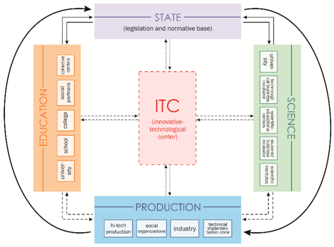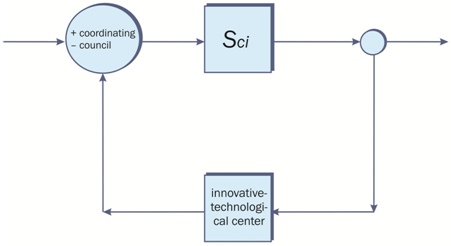ИНТЕГРАЦИЯ КЛАСТЕРОВ «НАУКА-ОБРАЗОВАНИЕ-ПРОИЗВОДСТВО»: ПРОБЛЕМА ВЗАИМОДЕЙСТВИЯ
Покровская Е.М.1, Раитина М.Ю.1, Горских О.В.2
1Кандидат философских наук, Доцент, 2Кандидат педагогических наук, Доцент, Томский государственный университет систем управления и радиоэлектроники
ИНТЕГРАЦИЯ КЛАСТЕРОВ «НАУКА-ОБРАЗОВАНИЕ-ПРОИЗВОДСТВО»: ПРОБЛЕМА ВЗАИМОДЕЙСТВИЯ
Аннотация
В статье рассмотрены основные подходы к проблеме интеграции базовых социальных институтов: наука-образование-производство. Авторы предлагают решение данной проблемы в контексте методологии «тройной спирали», предполагающей институциональное взаимодействие через уровневый механизм формирования кластерной среды. Данный механизм включает в себя три базовых уровня: уровень управления, уровень предложения, уровень спроса и реализации. В основу управления кластерным взаимодействием положен принцип поддержания стабильной работы с постоянной адаптацией к имеющимся условиям (к акутальному состоянию окружающей среды). Практическая значимость работы заключается в универсальности внедрения для корреляции комплексного функционирования системы.
Ключевые слова: методология «тройной спирали», уровневый механизм, кластерная среда.Pokrovskaya E.M.1, Raitina M.U.1, Gorskikh O.V.2
1PhD in Philosophy, Associate professor, 2PhD in Pedagogy, Associate professor, Tomsk State University of Control Systems and Radioelectronics
INTEGRATION OF SCIENTIFIC, EDUCATIONAL AND PRODUCTION CLUSTERS: THE PROBLEM OF INTERACTION
Abstract
The scientific problem of the article is concentrated on the search for new forms and ways of science-education-production clusters’ interacting. The authors propose a mechanism for the integration of clusters including control level, supply level, demand and implementation level; triggering mechanism for ensuring the effective interaction is the set of minimum necessary management actions formulated (articulated) for each level. Scientific and practical novelty consists in the development and description of an ideal model of clusters’ interaction management on the basis of the control deviation method.
Keywords: “triple helix” methodology, level mechanism, cluster’s environment.Introduction
Engineering education is now considered as a priority in the country that determines the growth of production efficiency and economy in the whole. Last decade in Russia it has been actively discussed the integration of science, education, production and finding new forms of their potentials’ connection. Scientific knowledge and experience on the issue that is needed to understand the processes of innovation and technological development, allow conceptualizing the model of science - education – production system interaction. Under cluster we understood a block of several objects, similar in functionality and assembled together for the convenience of access and increase performance. At present there is a large-scale network of cluster infrastructure. At the same time localization of its functioning is observed, including inadequate provision of general methodological and conceptual framework for cluster interaction support. For the successful formation of innovation infrastructure it is obligatory to make a set of scientific, organizational and theoretical activities, the main of which is the creation of innovation and technology centers, coordinating the cluster system functioning. It is noted that the topic of the clusters’ systems’ interaction in the context of transdisciplinarity, multidisciplinarity, interisciplinarity is relevant when searching for enhancing the effectiveness of various types of intellectual activity: education, fundamental research and solving engineering problems. According to H. Etzkowitz, new collaboration in the sphere of innovations among production (enterprises), education (universities) and science [4].
Subject and methods of research
Theoretical and methodological base of the research are the laws and principles of system analysis (integrity, complexity, unity, systemic), management theory, organization theory. As a basic research tool methods of system, strategic and expert analysis are used. To create a functional model of interaction management control deviation method is used. It suggests the presence of a system that continuously monitors the quality of training, scientific and technical activities and research results on the basis of foresight estimates and analysis of the demand for the different training fields. One of the basic characteristics of this method is the presence of feedback in the system, allowing to measure the system Si at any particular time, compared to a given management vector, and to develop control actions in the right direction.
Survey results analysis
The world practice shows that the development of innovative infrastructure is becoming a major feature of modern clusters, because it determines the effective mechanism of their functioning. However, the need to adapt it to the Russian reality is obvious. As noted in the literature [1–4], mostly clusters are aimed at achieving the following objectives:
- improving the competitiveness of all cluster members through the introduction of new technologies;
- formation of technological breakthrough vectors;
- knowledge commercialization;
- improving the efficiency of knowledge-intensive services through synergies;
- advanced development of knowledge generation environment.
Cluster types are defined on the various bases, e.g. on institutional, geographical, sectoral orientation (innovation, industrial, regional, transnational, etc.).
Considering ideas and concepts of implementation in the Russian practice we articulate a number of difficulties, namely:
- there is no systematic institutional interaction between scientific, educational and industrial clusters, and no mechanism of clusters’ systems’ interaction;
- there is a problem of implementation of research results and innovative scientific development and further commercialization;
- there is no long-term forecasting of training for the real economy;
- there are insufficiently implemented social, geopolitical, economic regulation of integration processes;
- there are not established tradition of innovative entrepreneurial thinking in scientific discourse.
Based on the problems mentioned above, we represent the institutional system of the cluster interaction science - education - production.
Fig. 1 – The cluster interaction system
Fig. 1 shows the functional elements’ relation of the cluster system, where the leading role is given to innovation and technology centers, performing an integrative part. We also note the need to develop a new methodology for cluster management systems and new principles of the state support mechanisms for cluster initiatives and cluster organizations [2].
To create a general methodological and conceptual framework we formulate the concept of innovation and technology center in relation to this study. Innovation and Technology Center serves as the organizational and managerial mechanism in the form of institutional cluster initiated by the state, fixed at the federal, regional, legislative levels, and supported by all members of the cluster interaction.
Discussion
In order to answer the question "How is it successfully to do effective management of cluster interaction?" It represents an ideal model of management in Fig. 2.
Fig. 2 – The ideal model of clusters’ interaction management
The basis of the clusters’ interaction management is the principle of maintaining stable functioning with constant adaptation to changing conditions (to the current state of the environment). The proposed mechanism provides the necessary precision, stability and control process quality. It is possible to calculate control algorithm of the effective clusters’ interaction mathematically by using the methods of mathematical programming, statistical methods, cognitive modeling, cybernetic models such as "input-output" for the solution of management problems.
This model includes a control system of the cluster interactions (Sci), innovative-technologicalcenter (ITC) serving as an integrator, the Coordinating Council performing function of a control action.
Considering the mechanism of clusters’ integration we highlight the basic structured levels that contain a set of minimum necessary actions to manage clusters. Objectives for each level are shown below.
Control level:
- to create a unified system of cluster interaction;
- to coordinate the demand of specialists of a certain level of qualification and offer appropriate jobs;
- to develop a systematic work on the development of innovation and entrepreneurial thinking society;
- to develop a strategic program for interaction in existing markets;
- to prepare the legal documentation, process interaction regulations;
- to carry out targeted intensive training with profiling students, the selection by the director of the company which holds the practice;
- to develop a system for evaluating the performance and interaction of clusters with a view to their timely reorganization in case of reduction or termination of their functionality.
Supply level:
- to increase participation in continuing education network sites: school-university-enterprise;
- To provide internship sites in the workplace;
- To ensure the employability of graduates;
- to extend the range and the area of innovation by disseminating scientific and educational and industrial cluster environment.
Demand and implementation level:
- to take into account the changing requirements of employers as the main customers of vocational education and its quality;
- to develop forecasts of skill requirements, to make predictive estimates;
- to build the database for target preparation;
- to accompany graduates, to provide consulting services for employment;
- to monitor the needs of the world market in the production/innovative scientific achievements;
- to expand requirements for the competence of workers in scientific and educational spheres.
Conclusion
The authors conclude:
- the proposed “ideal model” will help to build effective management of the cluster elements of the interaction on the basis of the control deflection method;
- developed by the authors, the mechanism of cluster interaction depending on the considered market may change the content of the estimates, spatial positioning, etc., using this “know-how” enables us to justify and build a successful integration system of science-education-production clusters with the aim of sustainable development of Russia's economy, the transfer of its innovative ideas and developments on the international market;
- it is necessary to carry out the monitoring and examination of existing successful interactions at specific local sites for the purpose of extrapolating them at regional, federal and international level;
- the main obstacle in the clusters’ interaction is the lack of a methodological framework for the cluster systems' management in the context of innovative interdisciplinary projects.
Список литературы / References
- Алексеев В. П. Системный анализ и методы научно-технического творчества / В. П. Алексеев, Д. В. Озеркин. – Томск : ТУСУР, 2012. – 183 с.
- Суслова Т. И. Человек в мире – мир в человеке / Т. И. Суслова, Е. М. Покровская, М. Ю. Раитина. – Томск : ТУСУР, 2012. – 162 с.
- Хайдуков Д. С. Применение кластерного анализа в государственном управлении. Философия математики: актуальные проблемы / Д. С. Хайдуков. – М. : МАКС Пресс, 2009. – 287 с.
- Etzkowitz H. The Dynamics of Innovation: from National Systems and “Mode 2” to a Triple Helix of University – Industry – Government Relations / H. Etzkowitz, L. Leydesdorff // J. Research Policy. – 2000. – № 29. – Р. 109–123.
Список литературы на английском языке / References in English
- Alekseev P. Sistemnyj analiz i metody nauchno-tehnicheskogo tvorchestva [System analysis and methods of scientific and technical creativity] / V. P. Alekseev, D. V. Ozerkin. – Tomsk : TUSUR, 2012. – 183 p. [in Russian]
- Suslova T. I. Chelovek v mire – mir v cheloveke [A human in the world – the world in a human] / T. I. Suslova, E. M. Pokrovskaja, M. Ju. Raitina. – Tomsk : TUSUR, 2012. – 162 p. [in Russian]
- Hajdukov D. S. Primenenie klasternogo analiza v gosudarstvennom upravlenii. Filosofija matematiki: aktual'nye problemy [Use cluster analysis in public administration. Philosophy of mathematics: actual problems] / S. Hajdukov – M. : MAKS Press, 2009. – 287 p. [in Russian]
- Etzkowitz H. The Dynamics of Innovation: from National Systems and “Mode 2” to a Triple Helix of University – Industry – Government Relations / H. Etzkowitz, L. Leydesdorff // J. Research Policy. – 2000. – № 29. – Р. 109–123.


